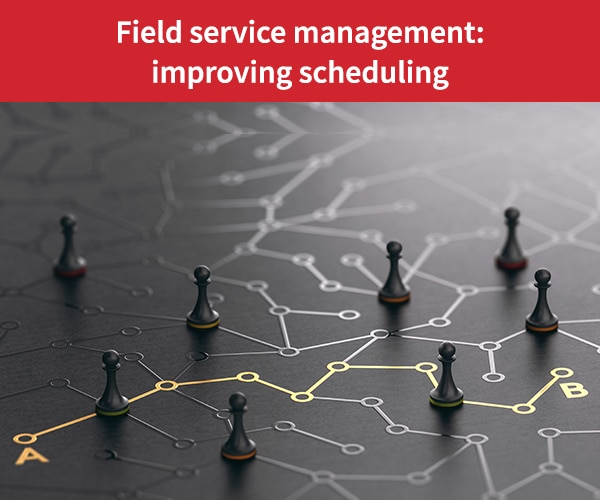
- Field Service Management
- Optimization
- Productivity
- Technician
- Work orders
5 Tips for Better Field Service Scheduling
Key Takeaways
Field service scheduling is not only about assigning jobs; it is about optimizing time, talent, and technology in real time. The following are the major insights that will help you become more efficient, responsive, and customer-oriented.
- Assign the technician to the job according to skills, availability, and location.
- Employ AI-based scheduling software to become faster, more accurate, and flexible.
- Balance regular and emergency service calls.
- Optimize technician routes to minimize travel time and maximize the number of jobs per day.
- Allow field technicians to make or change schedules using mobile applications.
- Customize schedules based on technician performance trends and customer familiarity.
- Track KPIs such as schedule compliance, response time, and software usage for continuous improvement.
Field service scheduling activities are a subtle art that must consider a large number of factors. The latest generation of field service management software simplifies the scheduling process and field scheduling tasks. However, because they are directly affected, maintenance technicians must also be involved.
Field service scheduling is THE key process for a maintenance department. The right skillset must be assigned to the right job at the optimal time.
And a large number of criteria, some unknown, must be juggled. For example, field service schedules must consider: Technician location, field service technician training, technician expertise, service urgency, likely duration of service activities, traffic and weather conditions, and spare parts availability.
Optimized field service scheduling is directly related to field team and technician productivity and customer satisfaction. The objectives are twofold: increase the first-time-fix rate and minimize technicians’ travel requirements so they can be in contact with customers as much as possible.
Field service management software must integrate these spatial and real-time aspects. It’s no longer adequate to simply create a list of service requests based on when the request came in, then assign it to the first available field service technician regardless of their location.
What are the biggest challenges in FSM scheduling?
Technician and service team management is essential in many industries, and scheduling is vital to this process. However, the process is accompanied by different complicated issues that can cause problems in terms of productivity, cost, and customer satisfaction. These are the major field service issues that organizations need to overcome to run the field service effectively.
Last-Minute Changes and Emergencies
A well-known issue in tech scheduling is handling schedule changes, such as unexpected service calls or customer rescheduling. These disruptions can disrupt even the best-laid-out schedules, causing delays in service delivery, no-shows for appointments, and resource wastage. Field service teams should be able to manage emergencies in a way that does not significantly affect the regular workflow. Failing to do so can result in long customer waiting times and low technician working rates.
Matching Technician Skills with Job Requirements
It is essential to ensure that the right technician is matched to the right job in field service management, but this is only sometimes possible. Technicians are of different categories, competency levels, certifications, and experience. If not correctly fitted to the job, it will take more time to complete, more callbacks, and a low first-time fix rate.
This is a significant scheduling issue because it directly determines the quality of the service to be delivered and the level of satisfaction that customers are likely to exhibit. Companies must consider each technician’s skills when assigning jobs so that they can produce the best results.
Geographic Distribution and Field Route Optimization
Clients are usually located in a large geographical area, and technicians need to visit all of them, so planning an efficient route is difficult. For instance, ineffective route planning can result in more extended time on the road, high fuel consumption, and fewer jobs accomplished per day. This is especially prevalent where the technicians are expected to move from one appointment to another over long distances, thus spending most of their time on the roads rather than fixing cars.
Field service route optimization is critical in ensuring productivity while reducing operational costs. Solving this field service scheduling issue can lead to timely service delivery and low customer satisfaction.
Balancing Routine Maintenance with Emergency Calls
Another major problem related to field tech scheduling is the proper time distribution between the scheduled maintenance work and emergency calls. While some equipment requires planned maintenance, others require emergency calls that interfere with the planned timetable. If poorly managed, this can result in a pile-up of simple tasks or a slow response to an emergency. It is, therefore, crucial to balance between these conflicting objectives in order for organizations to meet operational requirements and customers’ needs.
Lack of Real-Time Visibility into Field Operations
Field service scheduling is a complex process, and for it to be effective, one has to be able to monitor the technician’s availability, the progress of the job, and the technician’s location in real-time. If this data is available, dispatchers will find it easier to schedule correctly, leading to less overbooking, missed appointments, and scheduling conflicts.
Since schedules need to be monitored in real-time, it can be a hassle to adjust them in case of any changes, making the scheduling process difficult. This scheduling challenge is one of the most significant barriers to productivity and efficiency in this area and can affect the technician and the customer.
Field Service Scheduling Activities
The latest generation of field service management software simplifies the scheduling process and field service scheduling tasks. However, maintenance technicians must also be involved as they are directly affected.
Field service scheduling is THE key process for a maintenance department. This process must ensure that the right skillset must be assigned to the right job at the optimal time.
However, a large number of criteria must be juggled. For example, field service schedules must consider factors like: technician location, field service technician training, technician expertise, service urgency, likely duration of service activities, traffic and weather conditions, and spare parts availability.
Optimized field service scheduling is directly related to field team and technician productivity and customer satisfaction. According to a Bain and Company report, “5% can increase profits by between 25 percent and 95 percent.” The objectives are twofold: increase the first-time-fix rate while minimizing technicians’ travel requirements so they can be in contact with customers as much as possible.
Field service management software must integrate these spatial and real-time aspects. It’s no longer adequate to simply create a list of service requests based on when the request came in, then assign it to the first available field service technician, ignoring their location.
1. Make it simple
Field service scheduling is a delicate operation that requires flexibility. Dispatchers need a single, intuitive interface that shows real-time service activity and allows quick adjustments to daily schedules. To achieve this, the software must be both comprehensive and easy to use.
Here’s what an effective scheduling tool should enable:
- Drag and drop service calls to change appointment times or reassign jobs
- Instantly view which technicians’ routes pass closest to customer locations
- Manage emergency situations directly from the same interface
- Click on a route to see the technician’s availability and workload
- Click on a service call to add it to a route
- Automatically generate an optimized timeslot for the selected service call
With these capabilities, schedulers can make real-time changes in just a few clicks—helping teams stay agile and responsive without compromising efficiency.
2. Take advantage of AI for Smart Scheduling
With artificial intelligence (AI), field service schedulers have a new kind of colleague. Praxedo designed SmartScheduler for companies that manage a large number of service calls, field operations and need to consider many operational constraints. The automated field service software uses metaheuristic algorithms that can efficiently deliver results in just a few seconds.
AI engines combine all the necessary scheduling criteria, such as travel times and workload distribution among technicians, to quickly create routes and suggest the optimal service schedule.
They also consider business constraints, such as required approvals, when moving scheduled service calls, reassigning service calls, and exceeding technicians’ daily hours.
Scheduling is not static. The intelligent assistant updates schedules throughout the day, integrating emergencies and unforeseen events such as road accidents. However, AI doesn’t replace schedulers. Instead, it informs decision-making and collaborates to create the optimal schedule.
3. Balance recurring and emergency service requirements
Fortunately for field service schedulers, they don’t just manage emergency situations. They also fill technicians’ calendars with preventive maintenance tasks with known frequencies and durations. Because these activities are not emergencies, the field service dispatcher must add them to the right time window.
The challenge is to balance technicians’ workloads with the right mix of recurring and emergency tasks. Field service management software that considers real-time constraints and provides visibility on the progress of already-scheduled service calls is key to achieving this balance.
Field service schedulers must schedule recurring service calls while leaving time for emergency situations that may arise. The Praxedo software automates field service based on a predetermined time period and frequency for any given site, any single piece of equipment and for the equipment at the site.
4. Focus on the field
Even with AI and automation, scheduling technicians’ routes is difficult. Unforeseen events can mean pre-planned preventive maintenance must be postponed, resulting in non-compliance with service level agreements (SLAs).
Responsiveness is critical for service centers to reduce the reasons for customer dissatisfaction. Schedulers must be able to see all field activities so they’re aware at all times whether field teams are available, on the road, or at a service call and whether they are ahead of or behind schedule for the day.
Field service technicians should always have the last word on schedules, no matter what has been planned at the service center. That’s why field service management software must allow the field service technicians to set their own schedules if necessary. Techs can use a mobile app to see nearby service calls and assign a job to themselves if they’re available.
More generally, technicians must be involved in the factors that affect field service scheduling. For example, to avoid getting stuck with an impossible schedule, technicians should have a say in assessing the expected duration of a service call. Their contribution also makes it easier to adhere to scheduling policies.
Efforts must also be made to communicate with technicians and ensure they understand that real-time geolocation technology is not a means of policing them, but a way to make their routes more efficient to reduce travel times and improve their working conditions. When field service technicians are less stressed, customers benefit from better service in a true virtuous circle.
5. Make it personal
Field service managers can learn from the past to improve field service scheduling. For example, they can use the dashboards in reporting software to analyze the performance of individual technicians and teams of technicians. If the service manager knows a particular employee takes longer than average to complete a certain type of service call, there’s no point in assigning it to them as a priority. Similar considerations can be applied to technicians who are more efficient in the morning or at the beginning of the week. With this approach, technicians can be offered a schedule that’s personalized for their preferences.
Field service technicians may also have a close rapport with certain customers. For example, they may have established a relationship with the customer over the years or learned their maintenance requirements inside and out. It goes without saying that the technician should have priority for this account when it comes time to schedule service calls. The customer will enjoy more efficient service, and their satisfaction will be enhanced.
Measuring Success: Field Service KPIs for Field Service Scheduling
Field Technician Satisfaction
Organizations can measure this through regular surveys and feedback forms, where technicians can share their experiences and satisfaction levels regarding their schedules, workload, and ability to meet service demands.
Field Service Dispatcher Stress Levels
Track and assess dispatchers’ mental and emotional stress levels through check-in conversations and stress-assessment surveys to gauge the impact of scheduling challenges on their well-being.
Average Response Time
Calculate the average time a field service technician takes to reach a service location from the moment a request is made. This can be measured using GPS data and service logs.
Schedule Adherence Rate
Monitor the percentage of appointments that are met according to the original schedule without rescheduling or delays. The scheduling system data can help you track this.
Team Communication Effectiveness
Evaluate the effectiveness of team communication through anonymous surveys and the number of reported miscommunications or scheduling conflicts.
Cultural Adaptability to New Systems
Conduct focus groups and feedback sessions to measure the team’s adaptability to new scheduling systems and to understand resistance and acceptance levels.
Utilization Rate of Scheduling Software
Track the frequency and extent to which dispatchers and field technicians use the field service scheduling software. Metrics can include login times, features used, and the number of schedules created through the system.
Regulatory Compliance Adherence
Conduct periodic checks and compile reports to ensure that field service operations adhere to the country’s legal requirements and industry standards, such as labor laws and safety measures.
Conclusion: Smarter Scheduling, Stronger Service
Field scheduling is much more than job assignment. It is all about the combination of the correct tools, data, technician input and intelligent automation to make a flexible, responsive operation.
Addressing the typical scheduling problems, which include last-minute changes, mismatch of skills, inefficiencies in routes, and visibility issues, service teams can increase productivity and customer satisfaction significantly.
The purchase of intuitive AI-enhanced scheduling solutions can simplify daily operations and enable technicians to have real-time tools and flexibility in scheduling. And as teams get smarter and faster at planning, the outcome is a more powerful service culture of trust, speed and results.
Ready to take control of your field service operations? Contact us to find out how Praxedo can assist.
Frequently Asked Questions (FAQs)
1. What is service tech scheduling?
Field service scheduling involves planning who does what, where, and when. It is beneficial in terms of matching the right technician with the right job in terms of skills, availability, and location. Effective scheduling enhances customer satisfaction and team productivity.
2. Which is the best field service scheduling software for technicians?
The most effective scheduling tools are simple, intelligent, and built for the field. They assist dispatchers in planning more quickly and reacting to changes. Software like Praxedo is unique because it provides real-time updates, route planning, and mobile access, which makes the daily work of all people easier.
3. What is the role of AI in field service scheduling?
AI considers factors such as travel time, job urgency, and the workload of technicians. It assists in making superior schedules within seconds. AI also adapts to the changes throughout the day; therefore, teams remain flexible and efficient.
4. What is the importance of real-time visibility in field service?
When technicians are tracked in real-time, dispatchers have visibility of the teams and the status of jobs. It prevents delays, reduces confusion, and ensures that customers are more informed.
Our similar articles.
-
- Field Service Management
- Maintenance
- Gestion d’interventions
- IoT
- Technology
The value of drones to field service management
March 24, 2021 -
- Software
- Work Order Management
- Mobile App
- Work orders
Field service success: Ensure electronic reports contain these essential criteria
October 28, 2021 -
- Technician
- Maintenance
- Technicien
- Artificial Intelligence
Bringing the benefits of computer vision to maintenance technicians
November 4, 2020


